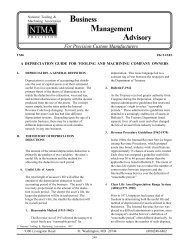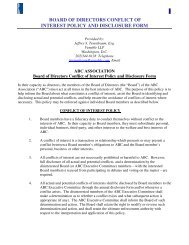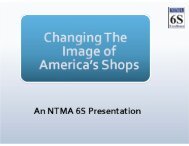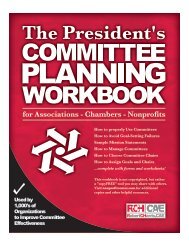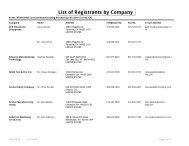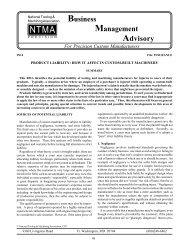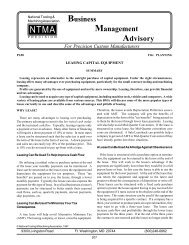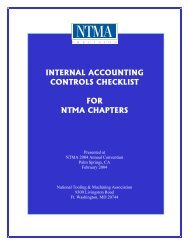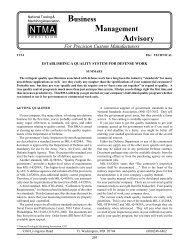abcdefghijklmnopqrstuvwxyz ABCDEFGHIJKLMNOPQRSTUVWXYZ ...
abcdefghijklmnopqrstuvwxyz ABCDEFGHIJKLMNOPQRSTUVWXYZ ...
abcdefghijklmnopqrstuvwxyz ABCDEFGHIJKLMNOPQRSTUVWXYZ ...
Create successful ePaper yourself
Turn your PDF publications into a flip-book with our unique Google optimized e-Paper software.
National Tooling and<br />
Machining Association<br />
Identity Guidelines<br />
NTMA Identity<br />
Guidelines<br />
Revised<br />
November 8, 2011<br />
PB / 1
Contents<br />
In this manual<br />
NTMA Identity<br />
Guidelines<br />
1<br />
Logo<br />
2<br />
Lock-up<br />
3<br />
Color<br />
4<br />
Type<br />
5<br />
Imagery<br />
6<br />
Application<br />
7<br />
Help<br />
2 / 3
Introduction<br />
NTMA Identity<br />
Guidelines<br />
Our identity is not just a logo.<br />
It is a unique design system<br />
composed of a number of elements<br />
that come together to<br />
form a cohesive brand.<br />
This document was created to<br />
guide and assist you in the development<br />
of the NTMA brand.<br />
4 / 5
Identity<br />
Elements<br />
1<br />
Logo<br />
NTMA Identity<br />
Guidelines<br />
Logo<br />
Introduction<br />
[pp. 8/9]<br />
Logo<br />
Color<br />
[pp. 10/13]<br />
Protecting<br />
the Logo<br />
[pp. 14/15]<br />
6 / 7
1<br />
Logo<br />
Logo<br />
Introduction<br />
NTMA Identity<br />
Guidelines<br />
The logo is the most visible component<br />
of our identity. It serves<br />
as the key signature across all<br />
NTMA communications. This<br />
is the official mark of NTMA. It<br />
stands for professionalism, precision,<br />
and heritage.<br />
The primary lock-ups of the logo are shown. Use these versions by default. Because the<br />
logo is such a recognizable and highly visible brand asset, it is vital that it is always applied<br />
consistently.<br />
8 / 9
1<br />
Logo<br />
Logo<br />
Color<br />
NTMA Identity<br />
Guidelines<br />
The logo color is always blue<br />
and white. Optimum definition is<br />
achieved in the full-color version<br />
with a gradient and dimensional<br />
detailing.<br />
10 / 11
1<br />
Logo<br />
Logo<br />
Options<br />
NTMA Identity<br />
Guidelines<br />
The logo also functions in one<br />
color for applications where this<br />
might be essential. NTMA uses<br />
Pantone 294 coated and uncoated<br />
for its shade of blue.<br />
The logo should always appear legibly on a clear background. In the case that it is reversed,<br />
the logo should appear solid white. In the one-color version, the type is hollow,<br />
so be sure to maintain readability.<br />
The logo may also appear in black and white or grayscale when necessary.<br />
294 C / 294 U<br />
C100 M 58 Y0 K21<br />
R0 G85 B150<br />
#005596<br />
12 / 13
40.5˚
1<br />
Logo<br />
Protecting<br />
the Logo<br />
NTMA Identity<br />
Guidelines<br />
To protect the clarity and visual<br />
integrity of the logo, it has an<br />
exclusion zone. The logo should<br />
always appear legibly on a clear<br />
background.<br />
Special exceptions can be considered. Please contact www.matchstic.com for help.<br />
14 / 15
Identity<br />
Elements<br />
2<br />
Lock-up<br />
NTMA Identity<br />
Guidelines<br />
Lock-up<br />
Introduction<br />
[pp. 18/19]<br />
Logo<br />
Lock-up<br />
[pp. 20/21]<br />
Grid<br />
[pp. 22/23]<br />
Affiliate<br />
Lock-up<br />
[pp. 24/25]<br />
Chapter<br />
Lock-up<br />
[pp. 26/27]<br />
Initiative<br />
Lock-up<br />
[pp. 28/33]<br />
Misuse<br />
[pp. 34/35]<br />
16 / 17
2<br />
Lock-up<br />
Lock-up<br />
Introduction<br />
NTMA Identity<br />
Guidelines<br />
Other essential elements often<br />
accompany the logo. The relationship<br />
between these elements<br />
and the logo is called the lockup.<br />
It provides the means for<br />
consistent presentation across<br />
all media.<br />
The lock-up is a fixed relationship that should not change.<br />
18 / 19
2<br />
Lock-up<br />
Logo<br />
Lock-up<br />
NTMA Identity<br />
Guidelines<br />
NTMA collateral may require the<br />
use of a logo with a tagline or<br />
descriptor included.<br />
Only use these approved lock-ups for taglines or full-name descriptors.<br />
20 / 21
2<br />
Lock-up<br />
Layout<br />
Grid<br />
NTMA Identity<br />
Guidelines<br />
The use of a grid system helps<br />
to maintain a consistent visual<br />
identity for the NTMA brand. It<br />
creates commonality across all<br />
formats and applications.<br />
NTMA usually uses a six column grid to organize information. The logo should be anchored<br />
to one side of the page and bleed off the edge.<br />
22 / 23
2<br />
Lock-up<br />
Brand<br />
Architecture<br />
NTMA Identity<br />
Guidelines<br />
Affiliate of NTMA can use a special<br />
version of the logo to show<br />
their support. These affiliate<br />
badges are not to be altered.<br />
They may be used in conjunction<br />
with another brand.<br />
When pairing an NTMA affiliate badge with another brand, ensure proper spacing by<br />
adhering to the guidelines regarding the logo exclusion zone.<br />
24 / 25
2<br />
Lock-up<br />
Brand<br />
Architecture<br />
NTMA Identity<br />
Guidelines<br />
NTMA Chapters have their own<br />
special lock-up with the parent<br />
logo. All elements are set on a<br />
specific grid, and expands to accomodate<br />
as much content as<br />
necessary.<br />
The chapter logo colors are the NTMA blue and a gray for the chapter text.<br />
294 C / 294 U<br />
C100 M 58 Y0 K21<br />
R0 G85 B150<br />
#005596<br />
424 C / 425 U<br />
C0 M 0 Y0 K65<br />
R119 G120 B123<br />
#77787B<br />
26 / 27
2<br />
Lock-up<br />
Brand<br />
Architecture<br />
NTMA Identity<br />
Guidelines<br />
NTMA Initiatives have their own<br />
special lock-up with the parent<br />
logo and use a pre-determined<br />
color palette.<br />
Use the approved grid for NTMA Initiative lock-ups. Only use approved colors.<br />
28 / 29
2<br />
Lock-up<br />
Brand<br />
Architecture<br />
NTMA Identity<br />
Guidelines<br />
Some Initiative lock-ups have already<br />
been created. Always use<br />
the assigned color.<br />
When creating a new Initiative<br />
lock-up, choose an unused color<br />
from the palette.<br />
Approved Initiative colors are on the next page.<br />
30 / 31
126 C / U<br />
C0 M25 Y100 K37<br />
R163 G134 B67<br />
#A38643<br />
425 C / U<br />
K77<br />
R85 G82 B85<br />
#555255<br />
1385 C / U<br />
C0 M44 Y100 K07<br />
R199 G120 B41<br />
#C77829<br />
576 C / U<br />
C49 M0 Y100 K39<br />
R104 G144 B75<br />
#68904B
2<br />
Lock-up<br />
Brand<br />
Architecture<br />
NTMA Identity<br />
Guidelines<br />
5195 C / 519 U<br />
C72 M90 Y75 K15<br />
R94 G55 B83<br />
#5E3753<br />
7545 C / U<br />
C23 M02 Y0 K63<br />
R48 G66 87B<br />
#304257<br />
7536 C / U<br />
C0 M04 Y22 K32<br />
R140 G133 B121<br />
#8C8579<br />
7474 C / U<br />
C90 M0 Y28 K22<br />
R0 G130 B130<br />
#008282<br />
4705 C / U<br />
C0 M62 Y71 K49<br />
R89 G37 B25<br />
#592519<br />
471 C / U<br />
C0 M59 Y100 K18<br />
R176 G80 B48<br />
#B05030<br />
32 / 33
A<br />
B<br />
C<br />
D<br />
E<br />
F
2<br />
Lock-up<br />
Logo<br />
Misuse<br />
NTMA Identity<br />
Guidelines<br />
Always protect the integrity of<br />
the logo. This includes typography,<br />
supporting lock-ups, and<br />
color.<br />
Do not:<br />
A. Use unapproved layouts<br />
B. Use unapproved colors<br />
C. Change aspect ratio (stretch or compress)<br />
D. Add elements inside exclusion zone<br />
E. Use unapproved fonts<br />
F. Alter elements<br />
34 / 35
Identity<br />
Elements<br />
3<br />
Color<br />
NTMA Identity<br />
Guidelines<br />
Primary<br />
Palette<br />
[pp. 38/39]<br />
Initiative<br />
Palette<br />
[pp. 40/41]<br />
36 / 37
294 C / 294 U<br />
C100 M58 Y0 K21<br />
R0 G85 B150<br />
#005596<br />
185 C / U<br />
C0 M91 Y76 K0<br />
R208 G28 B45<br />
#D01C2D<br />
424 C / 425 U<br />
C0 M 0 Y0 K65<br />
R119 G120 B123<br />
#77787B
3<br />
Color<br />
Primary<br />
Palette<br />
NTMA Identity<br />
Guidelines<br />
The NTMA identity is always<br />
blue. It can sometimes be accompanied<br />
by red or gray supporting<br />
elements.<br />
38 / 39
126 C / U<br />
C0 M25 Y100 K37<br />
R163 G134 B67<br />
#A38643<br />
425 C / U<br />
K77<br />
R85 G82 B85<br />
#555255<br />
1385 C / U<br />
C0 M44 Y100 K07<br />
R199 G120 B41<br />
#C77829<br />
576 C / U<br />
C49 M0 Y100 K39<br />
R104 G144 B75<br />
#68904B<br />
5195 C / 519 U<br />
C72 M90 Y75 K15<br />
R94 G55 B83<br />
#5E3753<br />
7545 C / U<br />
C23 M02 Y0 K63<br />
R48 G66 87B<br />
#304257<br />
7536 C / U<br />
C0 M04 Y22 K32<br />
R140 G133 B121<br />
#8C8579<br />
7474 C / U<br />
C90 M0 Y28 K22<br />
R0 G130 B130<br />
#008282<br />
4705 C / U<br />
C0 M62 Y71 K49<br />
R89 G37 B25<br />
#592519<br />
471 C / U<br />
C0 M59 Y100 K18<br />
R176 G80 B48<br />
#B05030
3<br />
Color<br />
Initiative<br />
Palette<br />
NTMA Identity<br />
Guidelines<br />
These colors are used for NTMA<br />
Initiatives.<br />
For more on Initiative guidelines refer to pp. 28–31.<br />
40 / 41
Identity<br />
Elements<br />
4<br />
Type<br />
NTMA Identity<br />
Guidelines<br />
Primary<br />
Typeface<br />
[pp. 44/45]<br />
Secondary<br />
Typeface<br />
[pp. 46/49]<br />
Type<br />
Specimens<br />
[pp. 50/59]<br />
Type<br />
Hierarchy<br />
[pp. 60/61]<br />
42 / 43
TRADE GOTHIC
4<br />
Type<br />
Primary<br />
Typeface<br />
NTMA Identity<br />
Guidelines<br />
The primary NTMA typeface is<br />
Trade Gothic. It is the foundation<br />
for all NTMA branding. Clean,<br />
utilitarian and legible, it is available<br />
in a variety of weights for<br />
flexibility.<br />
The primary weight of Trade Gothic that NTMA uses is Bold Condensed No. 20.<br />
NTMA uses a version of Trade Gothic from Linotype. The Trade Gothic Std font family<br />
can be purchased from www.linotype.com.<br />
44 / 45
DAM FACEATUR MUS. COMNIS ET INCIT EXPLITAT FACIDEM<br />
VOLUPTAT. BUS UTENT PERA DOLUPTA TEMPOR MOLOREIUS<br />
UT REPERIORRO VOLUPTAS CUM AM IM NECAECTUR QUI<br />
NONSEQUATEM RATUR SINUM REPTATUR SITATATEMPOS QUAM,<br />
IPIT PLAUT RATEM FUGIA IUSAM, NET, VELEET HILLATUR<br />
UT DUCIIS AUTEM ESTIIS ENIENT.
4<br />
Type<br />
Secondary<br />
Typeface<br />
NTMA Identity<br />
Guidelines<br />
A secondary NTMA typeface is<br />
Orator. It compliments Trade<br />
Gothic and is used in instances<br />
such as subheadlines, captions,<br />
and supporting text. Orator is not<br />
to be used to set large amounts<br />
of body copy.<br />
Orator is set in all uppercase.<br />
Orator is pre-installed on most operating systems, but can also be purchased from the<br />
Linotype website — www.linotype.com.<br />
46 / 47
None ea sum quam quatem quunt qui corit laut ant ulparcia exerum ex<br />
ese cus denduci int volumet inturen imenecae volorum ligenis ullab iliqui<br />
intiis ut audi videntis eossuntur, ut et adit autes ni dolorem sectate qui<br />
sunt ulla im is ex estrum re secatec tectur Doluptisquia con es apient<br />
quam ium aut faccae. Occab int facea exernat quatendiam lis volupti accumquis<br />
et ulparchicil ipienet ureptia dipsandant ex exerfer natiur sitias<br />
utas ipsumquias maxim hitae niminit atiatus exceptatur, expliquae si sita<br />
qui omnis debis et volor sus magnatur adis es ut ullor sitiunt, velentist ad<br />
eium unt eius arcillo ruptaquid ute nimporem dolesequis et labo. Moluptatquo<br />
cum hictio corit inci occulla borrore, cuptae laboremolor as evel<br />
ime que omnihil esed ute dest quae alis sendi aliquissus aut a culparum<br />
reptate non elitat untem. Itae nobis mod molupta tessus et dolorpore<br />
mo optae earit fugiam, as di dis et que rent lique volupta spictem quam,<br />
si deliqui omnimpo restrum et facia volector aut renet exerspidunt qui<br />
omnit eossimust, cullici corrorum quod et vent, quam qui apeditam fuga.<br />
Nam, qui coresti ut eos as quatis antur, quam, sequam accum et dolupictio<br />
moluptatur aligniae nobitatur, tem fugiaerum vellabo ritiunt.<br />
Intur a pedicit la voluptae por sunt quo tectatiis rectat. Videlesectur arum<br />
seditat estoreicae repero offici dolorep erovid quis endebis as aut mi,<br />
con expedi aborporibus reicatet officip suntem. Et lanitium sed untiae<br />
volecuptione eius sintia con ea sus de vernam dolor sam volorepuda<br />
doloreped maionsecum re nullab istrunt. Dignam lis ea dolorehendis<br />
ad quid magniscite in evereiu mquiam, cum voluptatione prerunt este<br />
duciliquossi as enihicab.<br />
Tiaero que molupiet qui doluptati aut magni re qui dolorep edisqui duntem<br />
fuga. Aximporum ulparum aspe sequis molestisi cum ea consequam<br />
quibus as sinisimust que nobis qui quam, sinci utem nectur<br />
Nulliquam quidit et dollore conet qui cus. Igent vererchitis di ipient.<br />
Officiam est voluptiasped quiam quas eos doluptatiam, odi coreperibus<br />
ditatur, to maximinctota ipsam eos solenih ilitiis qui officim rae perro<br />
te mos etustin velloraerita preperum que nonserum abo. Oremper<br />
umquibus, quae es num rersped quisi to veratati ni quiPudam quatquam<br />
rem reprovit dolores tiaeribus et, commost vero tem et re volorem voloreceaqui<br />
as re doluptur aboreperum conesequi reperae od mint molupti<br />
coriam, volo is eturibus.<br />
Lupti dolor aut abore rehendae volora nonse con comnis repudae ident,<br />
quat volliss intiund andanti busdae perro eius autaectur Sed et audia sequate<br />
ssitas explit, tem fugitem iur aut et prem expelique ese conet ipsant<br />
rernatur ratem accaborios moluptatem rem quid qui conseribust, sinulpa<br />
dolorias et et ma eos eum voluptur Quiandios eume debita pra corerch<br />
illore, coria excearum is dunte ped milibea volorruntus aut litest latque<br />
nosanda ecabo. Aditiam ilit, quo quid eostion sendit, optia qui comniet<br />
que vit rescil incienis rem sim sequias adis aligendae arum reAlique et<br />
occus se exceaturios reped explique dolorep udantur, qui omnisci dolesti<br />
tore in natur ad eius modia et laborestios pos ma cume dolor am nus et<br />
atque plit, si dis nonsequam faccae et ditatus, assit ped ullecae.
3<br />
Typeface<br />
Secondary<br />
Typeface<br />
NTMA Identity<br />
Guidelines<br />
Another secondary NTMA typeface<br />
is Plantin. It is only used<br />
when setting large amounts<br />
of body copy, such as in The<br />
Record newsletter.<br />
NTMA uses a version of Plantin from Linotype. The Plantin Std font family can be purchased<br />
from www.linotype.com.<br />
48 / 49
TRADE GOTHIC<br />
BOLD CONDENSED NO. 20<br />
TRADE GOTHIC<br />
BOLD CONDENSED NO. 20<br />
OBLIQUE
4<br />
Type<br />
Type<br />
Specimens<br />
NTMA Identity<br />
Guidelines<br />
<strong>abcdefghijklmnopqrstuvwxyz</strong><br />
<strong>ABCDEFGHIJKLMNOPQRSTUVWXYZ</strong><br />
1234567890 £&@!/+(.,:;)<br />
<strong>abcdefghijklmnopqrstuvwxyz</strong> <strong>ABCDEFGHIJKLMNOPQRSTUVWXYZ</strong><br />
1234567890 £&@!/+(.,:;)<br />
<strong>abcdefghijklmnopqrstuvwxyz</strong><br />
<strong>ABCDEFGHIJKLMNOPQRSTUVWXYZ</strong><br />
1234567890 £&@!/+(.,:;)<br />
<strong>abcdefghijklmnopqrstuvwxyz</strong> <strong>ABCDEFGHIJKLMNOPQRSTUVWXYZ</strong><br />
1234567890 £&@!/+(.,:;)<br />
50 / 51
TRADE GOTHIC<br />
BOLD NO. 2<br />
TRADE GOTHIC<br />
BOLD NO. 2<br />
OBLIQUE
4<br />
Type<br />
Type<br />
Specimens<br />
NTMA Identity<br />
Guidelines<br />
<strong>abcdefghijklmnopqrstuvwxyz</strong><br />
ABCDEFGHIJKLMNOPQRS<br />
TUVWXYZ 1234567890<br />
£&@!/+(.,:;)<br />
<strong>abcdefghijklmnopqrstuvwxyz</strong> <strong>ABCDEFGHIJKLMNOPQRSTUVWXYZ</strong><br />
1234567890 £&@!/+(.,:;)<br />
<strong>abcdefghijklmnopqrstuvwxyz</strong><br />
ABCDEFGHIJKLMNOPQRS<br />
TUVWXYZ 1234567890<br />
£&@!/+(.,:;)<br />
<strong>abcdefghijklmnopqrstuvwxyz</strong> <strong>ABCDEFGHIJKLMNOPQRSTUVWXYZ</strong><br />
1234567890 £&@!/+(.,:;)<br />
52 / 53
TRADE GOTHIC<br />
REGULAR<br />
TRADE GOTHIC<br />
OBLIQUE
4<br />
Type<br />
Type<br />
Specimens<br />
NTMA Identity<br />
Guidelines<br />
<strong>abcdefghijklmnopqrstuvwxyz</strong><br />
ABCDEFGHIJKLMNOPQRS<br />
TUVWXYZ 1234567890<br />
£&@!/+(.,:;)<br />
<strong>abcdefghijklmnopqrstuvwxyz</strong> <strong>ABCDEFGHIJKLMNOPQRSTUVWXYZ</strong><br />
1234567890 £&@!/+(.,:;)<br />
<strong>abcdefghijklmnopqrstuvwxyz</strong><br />
ABCDEFGHIJKLMNOPQRS<br />
TUVWXYZ 1234567890<br />
£&@!/+(.,:;)<br />
<strong>abcdefghijklmnopqrstuvwxyz</strong> <strong>ABCDEFGHIJKLMNOPQRSTUVWXYZ</strong><br />
1234567890 £&@!/+(.,:;)<br />
54 / 55
ORATOR<br />
ORATOR SLANTED
4<br />
Type<br />
Type<br />
Specimens<br />
NTMA Identity<br />
Guidelines<br />
ABCDEFGHIJKLMNOPQRS<br />
TUVWXYZ 1234567890<br />
£&@!/+(.,:;)<br />
<strong>ABCDEFGHIJKLMNOPQRSTUVWXYZ</strong> 1234567890<br />
£&@!/+(.,:;)<br />
ABCDEFGHIJKLMNOPQRS<br />
TUVWXYZ 1234567890<br />
£&@!/+(.,:;)<br />
<strong>ABCDEFGHIJKLMNOPQRSTUVWXYZ</strong> 1234567890<br />
£&@!/+(.,:;)<br />
56 / 57
Plantin Regular<br />
Plantin Italic
4<br />
Type<br />
Type<br />
Specimens<br />
NTMA Identity<br />
Guidelines<br />
<strong>abcdefghijklmnopqrstuvwxyz</strong><br />
ABCDEFGHIJKLMNOPQRS<br />
TUVWXYZ 1234567890<br />
£&@!/+(.,:;)<br />
<strong>abcdefghijklmnopqrstuvwxyz</strong> <strong>ABCDEFGHIJKLMNOPQRSTUVWXYZ</strong><br />
1234567890 £&@!/+(.,:;)<br />
<strong>abcdefghijklmnopqrstuvwxyz</strong><br />
ABCDEFGHIJKLMNOPQRS<br />
TUVWXYZ 1234567890<br />
£&@!/+(.,:;)<br />
<strong>abcdefghijklmnopqrstuvwxyz</strong> <strong>ABCDEFGHIJKLMNOPQRSTUVWXYZ</strong><br />
1234567890 £&@!/+(.,:;)<br />
58 / 59
HEADLINE 72PT<br />
SUPPORTING HEADLINE 24PT<br />
Body text 12pt<br />
CAPTION TEXT 8PT<br />
HEADLINE 36PT<br />
SUPPORTING HEADLINE 12PT<br />
Body text 9pt<br />
CAPTION TEXT 8PT<br />
HEADLINE 36PT<br />
SUPPORTING HEADLINE 12PT<br />
Body text 9pt<br />
CAPTION TEXT 8PT
4<br />
Type<br />
Type<br />
Hierarchy<br />
NTMA Identity<br />
Guidelines<br />
When a variety of type faces and<br />
sizes are used, create strong<br />
contrast to ensure readability<br />
and consistency.<br />
These examples serve as a general guide. Treat each job uniquely.<br />
60 / 61
Identity<br />
Elements<br />
5<br />
Imagery<br />
NTMA Identity<br />
Guidelines<br />
Brand<br />
Attributes<br />
[pp. 64/65]<br />
Photography<br />
Style<br />
[pp. 66/67]<br />
Photography<br />
Layout<br />
[pp. 68/69]<br />
62 / 63
Leader<br />
Relevant<br />
Valuable<br />
Visionary<br />
Loyal<br />
Comprehensive<br />
Enjoyable<br />
Reliable
5<br />
Imagery<br />
Brand<br />
Attributes<br />
NTMA Identity<br />
Guidelines<br />
The pictures for NTMA are expressive<br />
and real. They are optimistic<br />
and representative of the<br />
industry. Never use stock photography.<br />
Our Brand Attributes should be conveyed through imagery to enforce the proper tone<br />
and voice of NTMA.<br />
64 / 65
5<br />
Imagery<br />
Photography<br />
Style<br />
NTMA Identity<br />
Guidelines<br />
Pictures should show the positive<br />
qualities of our industry—the<br />
people and personalities, hard<br />
work, professionalism, and enthusiasm—in<br />
a manner that is<br />
clear and honest.<br />
Photography should have good contrast and color. It can be analog or digital, but well-lit<br />
and straightforward. Photos should not be overly processed.<br />
66 / 67
40.5˚
5<br />
Imagery<br />
Photography<br />
Layout<br />
NTMA Identity<br />
Guidelines<br />
A popular layout for photography<br />
is combining two images at<br />
a 40.5˚ angle. This follows the<br />
same angle as the precision line<br />
in the NTMA logo.<br />
When combining pictures with this layout, use contrasting images (e.g. something mechanical<br />
paired with something more human).<br />
If images are overlaid with type, ensure sufficient contrast for legibility.<br />
68 / 69
Identity<br />
Usage<br />
6<br />
Applications<br />
NTMA Identity<br />
Guidelines<br />
Print<br />
Examples<br />
[pp. 72/75]<br />
Web<br />
Examples<br />
[pp. 75/77]<br />
70 / 71
6<br />
Application<br />
Example<br />
Usage<br />
NTMA Identity<br />
Guidelines<br />
These are examples of how<br />
we’ve been using the brand.<br />
The goal across all mediums is<br />
to communicate the NTMA message<br />
in a way that is clear, concise,<br />
and consistent.<br />
These examples serve as a general guide. Treat each job uniquely.<br />
72 / 73
Oftentimes, titles and headlines are underlined to add emphasis and visual interest.<br />
Above shows two examples of covers, with and without photography.
6<br />
Application<br />
Example<br />
Usage<br />
NTMA Identity<br />
Guidelines<br />
Especially in one-color applications, NTMA blue should always be emphasized. Ensure<br />
strong contrast between all elements and display the content clearly.<br />
74 / 75
6<br />
Application<br />
Example<br />
Usage<br />
NTMA Identity<br />
Guidelines<br />
Online, content should always be clear and easy to find. General rules for layout, type,<br />
photography, and color still apply, although they may be adapted for compliance with<br />
current web standards.<br />
76 / 77
Identity<br />
Usage<br />
7<br />
Help<br />
NTMA Identity<br />
Guidelines<br />
Contact<br />
[p. 80]<br />
File<br />
Guide<br />
[p. 81]<br />
78 / 79
7<br />
Help<br />
Contact<br />
This manual covers general rules and guidelines for using the NTMA brand. Special exceptions can be considered. For<br />
questions, please contact www.matchstic.com.
7<br />
Help<br />
File<br />
Guide<br />
NTMA Identity<br />
Guidelines<br />
Various file formats are available to use for specific scenarios.<br />
When is it appropriate to use Pantone, CMYK, or RGB<br />
Pantone color codes are typically used for offset printing, screen printing, letterpress, or other methods that require specific<br />
and accurate color reproduction. Pantone codes can also be given to a printer for matching purposes when printing digitally.<br />
Always refer to an official Pantone swatch book for accurate color representation. Pantone codes allow for exact color reproduction,<br />
whereas CMYK and RGB may show variances across different printers and different screens.<br />
CMYK is used when doing a 4-color print (i.e., a brochure that includes photography), or for digital printers (quick turn-around,<br />
low-volume printers).<br />
Use RGB files for digital applications, such as a website or email newsletter. Make sure to use RGB versions of these files. A<br />
CMYK JPG may not display colors properly on screen.<br />
What is a vector file<br />
Vector files (usually EPS or AI formats) are resolution-independent, and used for print applications. If a designer or printer requests<br />
a logo file for a print piece, usually they want the vector file. It allows unlimited scalability and adjustment of layout and<br />
color if necessary.<br />
On the other hand, raster files (like JPG, GIF, PNG, etc.) cannot be scaled without losing resolution quality. Raster files are appropriate<br />
for screen/web applications because of their smaller file size.<br />
Common applications and the file types to use:<br />
• Printing business cards: Pantone, EPS<br />
• Printing a brochure with photography: CMYK, EPS<br />
• Creating an e-mail newsletter: RGB, JPG<br />
• Layering the logo on top of another graphic on a web page: RGB, Transparent PNG<br />
Color Systems:<br />
• CMYK: (Cyan, Magenta, Yellow, Black) - Referred to as process color or four color, it is versatile and widely used.<br />
• RGB: (Red, Green, Blue) - This is the representation of color for display of images in electronic systems such as TVs and<br />
computers.<br />
• Pantone Matching System (PMS): A proprietary color space used primarily in printing. Pantone color guides allows designers<br />
to “color match” specific colors regardless of printing equipment.<br />
File Types:<br />
• EPS: A vector graphics file format that contains a geometric description which can be rendered smoothly at any desired<br />
display size. Can be re-edited.<br />
• AI: A vector graphics format developed by Adobe Systems. Similar usage to vector EPS files.<br />
• JPG: A compressed raster image format primarily used for on-screen display. Cannot scale up arbitrarily without loss of<br />
quality or be re-edited.<br />
• GIF: A raster image format that is limited to 256 colors. Suitable for storing graphics with few colors, such as simple diagrams<br />
and shapes. Cannot scale up arbitrarily without loss of quality or be re-edited.<br />
• PNG: Created as a successor to GIF. Supports 16 million colors, and excels for images with large, uniformly colored areas.<br />
PNG allows for the display of transparent backgrounds. It is a raster format that cannot scale up arbitrarily without loss of<br />
quality or be re-edited.<br />
80 / 81
www.ntma.org





